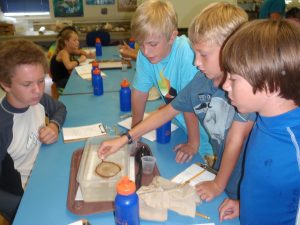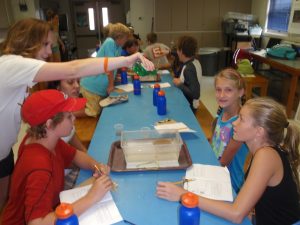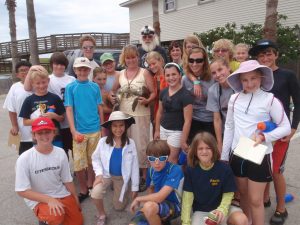Texas Students Put Oil Spill Cleanup Methods to the Test
– August 28, 2013
The methods used to remove the oil from the Gulf of Mexico – skimming, soaking, and dispersing – were as much in the news as the Deepwater Horizon incident itself.
Three years later, a group of twenty-six middle school students conducted experiments to compare these methods as part of a week-long University of Texas Summer Science Field Program. The Marine Science Institute (UTMSI) in Port Aransas hosted the field program, focusing on the Gulf’s marine ecosystem.
UTMSI post-doctorate Rodrigo Almeda and graduate student Tracy Harvey led the oil-spill activities at the science field program. They are members of Dr. Edward Buskey’s laboratory team for the research consortium Dispersion Research on Oil: Physics and Plankton Studies (DROPPS). The DROPPS consortium is studying how oil breaks down into droplets, travels under various conditions, and interacts with the plankton in the marine environment.
The 5th through 8th grade students started the day with Harvey giving an overview of current oil spill research and potential effects oil and dispersants can have on plankton and the food web. To make the science concepts behind oil spill cleanup more informative, Almeda and Harvey guided the students through the scientific process using a lab experiment with three treatments designed to simulate remediation techniques. The students were asked to develop hypotheses, conduct the experiments, and explain their conclusions regarding the most effective method to remove surface oil. After the experiments, the students discussed how oil might act under different conditions – with waves, in a lake or river, and on water surface and seafloor.
The students enthusiastically conducted the experiments. To test soaking, they put cotton in a container with water and vegetable oil, left it for 30 seconds, and scooped out the cotton with a slotted spoon. To test skimming, students used a straw with a string looped through it to pull oil to one place within the container and then used a pipette to suck out the oil. To test dispersing, they added dish soap to oiled water, stirred it for 5 seconds, and then waited for a minute. After each experiment, the students used a grid to plot the percent of visible oil left on the water’s surface, which they measured using a transparency with 100 squares to see the percent cover of oil on the surface.
The majority of students concluded that dispersing was most effective in removing the oil, with soaking coming in a distant second. However, some students raised questions about the meaning of “effective oil removal” especially after seeing the dramatic dispersal from the soap treatment and taking measurements only of surface oil. Almeda and Harvey used the outcomes and questions to explain the concept that just because oil was not visible on the surface did not mean it was completely gone. They described how oil can break down into tiny droplets that mix with water, potentially harming the food chain by killing copepods and other organisms that larger marine animals eat. The instructors and students had a discussion about the complex nature of this situation and some of the choices scientists and first responders must make in times of environmental crisis.
Most of the students started the day with a good awareness about the oil spill incident and general problems with wildlife and the coast environment. But by day’s end, they had new insights. Julie Findley, a Master Teacher for the University of Texas Summer Science Program, said, “The idea that dispersant is detrimental to copepods, and therefore to the food webs and other wildlife, was new to them, and an important idea.” Colleen McCue, the program coordinator, attributed the lab activities as being “successful in encouraging students to think critically about real world environmental problem-solving situations.”
The DROPPS consortium believes that working with young students and helping them understand their research is an important investment in the future. “Active investigations such as oil spill experiments stimulate students’ senses as well as their minds,” said Findley. She continued, “When children touch and smell oil and see its effects, when they get it on their hands and the science equipment, they will remember the experience and understand why it is important to know how serious oil spills are and how difficult they are to clean up. Teaching science should include lessons on conservation and environmental issues, as students will be the problem solvers of the future.”
The UT Summer Science Program is funded through the University of Texas Marine Science Institute, the Mission-Aransas National Estuarine Research Reserve, the Coastal Bend Bays and Estuaries Program and the City of Port Aransas. For more information on UT Summer Science Program, please visit www.utsummerscience.org.
This research was made possible in part by a Grant from BP/The Gulf of Mexico Research Initiative (GoMRI) through the Dispersant Research on Oil: Physics and Plankton Studies (DROPPS). The GoMRI is a 10-year, $500 million independent research program established by an agreement between BP and the Gulf of Mexico Alliance to study the effects of the Deepwater Horizon incident and the potential associated impact of this and similar incidents on the environment and public health.
© Copyright 2010-2017 Gulf of Mexico Research Initiative (GoMRI) – All Rights Reserved. Redistribution is encouraged with acknowledgement to the Gulf of Mexico Research Initiative (GoMRI). Please credit images and/or videos as done in each article. Questions? Contact web-content editor Nilde “Maggie” Dannreuther, Northern Gulf Institute, Mississippi State University (maggied@ngi.msstate.edu).








